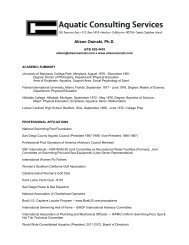NATIONAL JOURNAL - Aquatic Consulting Services
NATIONAL JOURNAL - Aquatic Consulting Services
NATIONAL JOURNAL - Aquatic Consulting Services
You also want an ePaper? Increase the reach of your titles
YUMPU automatically turns print PDFs into web optimized ePapers that Google loves.
<strong>NATIONAL</strong><br />
VOLUME 2, ISSUE 4<br />
<strong>JOURNAL</strong> FALL 1986<br />
In This Issue:<br />
Water Skiing • Scuba in the University • <strong>Aquatic</strong>s in Total Fitness • Drowning<br />
• Families in the Water • 35th Anniversary Conference Schedule •<br />
• Swimming in a Cross Current • Aquascope •<br />
THE COUNCIL FOR <strong>NATIONAL</strong> COOPERATION IN A
DROWNING<br />
Alison Osinski<br />
An individual finds himself unexpectedly in the water.<br />
Unable to save himself because of lack of swimming ability<br />
or injury, and unable to summon assistance which<br />
should be readily and immediately available, he panics,<br />
struggles briefly on the surface of the water and then<br />
slips below.<br />
After submerging, he holds his breath until no longer<br />
able. He eventually resigns himself to the fact that he<br />
is going to drown, and a sense of calm overtakes him.<br />
As he begins to lose consciousness from asphyxia, the<br />
reflex closure of his glottis is overcome by the need to<br />
breathe. He inhales a large quantity of water, then begins<br />
to vomit. The regurgitated water and vomit are<br />
aspirated into his lungs. As he begins to sink deeper in<br />
the pool, the increased water pressure on his chest forces<br />
the remaining air out of his lungs. The water now in<br />
his lungs passes into his bloodstream and dilutes the<br />
blood. As the salt concentration of his blood is lowered,<br />
the red blood cells begin to burst into the surrounding<br />
plasma and be destroyed. The hemolysis causes a frothy<br />
pink fluid to build up in his lungs and a tremendous<br />
swelling to take place. An electrolyte imbalance developes<br />
as calcium levels decrease because of the blood dilution,<br />
and potassium levels increase due to the break<br />
up of the red blood cells. As a result of this electrolyte<br />
imbalance and oxygen deprivation, his heart is forced<br />
into ventricular fibrillation. Within a short time, he is<br />
clinically dead.<br />
He lies submerged in deep water for an undetermined<br />
amount of time, until eventually spotted. After being<br />
pulled from the water, he is positioned and checked for<br />
respiratory and cardiac arrest. Resuscitation attempts<br />
are hampered due to the lack of any sort of established<br />
and practice emergency action plan. The lifeguards do<br />
not have the knowledge, nor the training, to deal with<br />
this catastrophic emergency. Confused over the proper<br />
techniques, and unprepared for the physiological<br />
responses of the body to drowning, the guards are not<br />
able to apply the proper emergency first aid procedures.<br />
Biological death follows.<br />
A number of acts on the part of the lifeguards on duty,<br />
and ultimately management, contributed to this drowning.<br />
The lifeguards failed in their duty to protect the victim<br />
from risk of harm. They did not give him the degree<br />
or standard of care owed by competent and trained<br />
professionals. And, they acted below the approved standard<br />
of care in their rescue attempts after being made<br />
aware of this situation.<br />
Substantial factors contributing to this drowning may<br />
have included: lack of lifeguard training for the facility,<br />
lack of proper supervision, lack of proper surveillance<br />
techniques, distraction from surveillance duties, intrusion<br />
of non-guard duties upon the lifeguards, failure to<br />
recognize a drowning victim, water quality which inhibited<br />
the observation of a submerged victim, no established<br />
and practiced emergency action plan for<br />
drowning, and improper application of first aid techniques,<br />
particularly cardiopulmonary resuscitation.<br />
This drowning occurred in a supervised pool with<br />
lifeguards on duty. This loss of life should never have<br />
occurred, and never would have, had the lifeguards correctly<br />
performed their primary responsibilities.<br />
Of the thousands of accidental drownings which occur<br />
annually in the United States, disturbingly, about ten<br />
percent follow this scenario, and take place in supervised<br />
areas with lifeguards on duty. Since a lifeguard's<br />
primary responsibility is to protect bathers from drowning<br />
and other water related injuries, the fact that a<br />
drowning occurs often shows dereliction of duty, and at<br />
a minimum, negligence on the part of the lifeguards<br />
charged with protecting bathers from harm.<br />
Unfortunately, most trained and certified lifeguards<br />
do not know what a drowning victim looks like. They<br />
have not been exposed to an accurate description of<br />
causes of drowning, and are unaware of what happens<br />
physiologically and emotionally to a drowning victim.<br />
Often lifeguards are not familiar with the profile of individuals<br />
most at risk of becoming drowning victims.<br />
Many guards fail to recognize a drowning victim or see<br />
the drowning take place, because of their lack of training<br />
in this aspect of the job of lifeguarding, and because<br />
of their inattention to, or distraction from, their duty.<br />
Profile of Drowning Victims<br />
McCloy and Dodson (1980) questioned why people become<br />
fatalities while engaged in aquatic activities, and<br />
which groups were most at risk. Their findings showed<br />
that females tended to drown much less frequently than<br />
males in all age groups. When the 515 recreationallyrelated<br />
drownings reviewed in their study were broken<br />
down by type of water body, it was found the leading<br />
site for drownings was swimming pools, and 48% of those<br />
pool drownings happened in apartment complex pools.<br />
Deitz and Baker, in their 1974 study of drownings,<br />
found "the dead man's float is a phenomenon peculiar<br />
to those who are alive and those who have been dead<br />
long enough for putrefactive gas formation to have<br />
raised the body to the surface." Lack of supervision was<br />
an important factor in drownings. Unattended and unsupervised<br />
children found their way into swimming<br />
pools. 75% of drownings studied were witnessed by persons<br />
old enough to have saved the victims through use<br />
of lifesaving and resuscitation techniques.<br />
The Council for National Cooperation in <strong>Aquatic</strong>s<br />
(CNCA) has reviewed data on drowning for several<br />
years, and has consistently found that approximately<br />
85% of drowning victims are male, l/5th of all drownings<br />
happen in the peak month of July, about 40% occur<br />
on Saturdays and Sundays, about two thirds occur<br />
in the afternoon and early evening, and about two thirds<br />
of victims do not know how to swim. The most frequent<br />
proximate cause of drowning is unintentional falling or<br />
slipping into the water. Lack of adult supervision is<br />
another important factor.<br />
Smith (1984) has presented the most up to date statistics<br />
on drowning. Two thirds of aquatic accident victims<br />
can't swim. Two thirds of victims had no intention of<br />
entering deep water. In 1979, 850 of the 7000 drownings<br />
that occurred in the U.S. were to children between<br />
the ages of 5 and 14 years old. Most drownings occur
10 to 30 feet from safety.<br />
Recognition of a Drowning Victim<br />
First, a distinction should be made between a distress<br />
victim, and a drowning victim. A distress victim is one<br />
who is unable to get to safety without some sort of assistance.<br />
He/she may have some swimming skills, but<br />
cannot make forward progress toward safety. A distress<br />
victim is able to breathe and may be able to wave or call<br />
for help. The victim's buoyancy alternates between neutral<br />
and positive. The average person when suspended<br />
motionless in water will submerge to about eye level in<br />
a vertical position. They will make lifting motions in<br />
an attempt to swim and to raise themselves above the<br />
surface of the water, but only up and down movement<br />
and little or no forward progress will result. A distress<br />
victim may become panicky and pass in to being an actively<br />
drowning victim if assistance is not rendered.<br />
There are two types of drowning victims. Passive victims<br />
and active victims.<br />
Passive victims are those who experience a sudden loss<br />
of consciousness while in the water. For example, those<br />
who suffer a heart attack, sudden cold water immersion,<br />
stroke, collision resulting in injury to the head, or epileptic<br />
seizure while in the water can become passive drowning<br />
victims. They make no attempt to get attention, may<br />
float face down on the surface or may slip below the<br />
water .surface without warning.<br />
Active victims are rarely able to call out for help since<br />
their primary concern is breathing. Most lapse into instinctive<br />
involuntary arm movements which are<br />
designed to bring the victim's head up and above water.<br />
Arms are extended out at the sides and push down on<br />
the water. The mouth is open and tilted backward to increase<br />
air intake. The victim can't see, hear, or react<br />
to instructions. Usually the victim manages to turn<br />
toward safety or shore. The body is in a vertical rather<br />
than horizontal position in the water. The victim gradually<br />
and continually sinks lower and lower in the water,<br />
as he passes from neutral to negative buoyancy. Immediately<br />
before submerging completely below the surface<br />
of the water, the victim's hands are seen grasping<br />
towards the surface. After a brief struggle, a drowning<br />
victim will be seen lying motionless underwater. This<br />
sequence of drowning usually occurs within 20-60 seconds<br />
of entering deep water.<br />
Frank Pia, chief lifeguard for Orchard Beach, Long Island,<br />
and well known aquatic expert, has filmed actual<br />
drowning and distress victims as they struggled off Orchard<br />
Beach. The film, "On Drowning" is the result of<br />
his efforts. To corroborate the filmed evidence of drowning<br />
behavior, Prank Pia has performed drowning experiments<br />
with himself as victim. He tied his legs together,<br />
wore a 20 pound weight belt, had a line tied around his<br />
chest and attached to his assistant standing on the pool<br />
deck. After 40 seconds of immersion, he exhibited typical<br />
drowning responses. He panicked, he struggled involuntarily,<br />
his respiration and heart rate increased, his<br />
arms flailed in and out of the water in unison, he bobbed<br />
vertically, his head tilted backward with mouth in the<br />
universal sign of drowning, and he was not able to call<br />
for help.<br />
Physiological Responses To Drowning<br />
Drowning is a type of asphyxia related to either aspiration<br />
of fluids or obstruction of the airway caused by<br />
a spasm of the larynx.<br />
In salt water submersions, the high concentration of<br />
salt in the water which has been ingested causes fluid<br />
from the bloodstream to pass into and flood the lungs.<br />
A sudden fall in blood pressure will result in circulatory<br />
collapse, shock, and death.<br />
In 90% of fresh water submersion cases, carbon dioxide<br />
builds up as the victim holds his breath, the larynx<br />
relaxes, water is swallowed, regurgitation occurs, and<br />
water and vomit enter the lungs. Water inhaled into the<br />
victim's lungs is absorbed within two to three minutes<br />
into the bloodstream and dilutes the blood. Blood volume<br />
increases. Red blood cells are destroyed as the salt concentration<br />
of the blood lowers. Oxygenated blood cannot<br />
get to the brain. Hypoxia and brain damage occur.<br />
The pupils dilate. Conscious struggling stops; convulsions<br />
and twitching begin. The lungs may be empty, but<br />
more commonly swelling occurs and a frothy pink fluid<br />
builds up in the lungs as a result of hemolysis, the rupturing<br />
of the red blood cells. Hemodilution causes an<br />
electrolyte imbalance. Calcium levels decrease and<br />
potassium levels increase. Ventricular fibrillation and<br />
clinical death follow.<br />
In the other 10% of drownings, dry drowning occurs.<br />
Laryngospasm, the automatic blockage of the breathing<br />
passages, occurs. Little or no water enters the lungs.<br />
Breathing stops and death is the result of asphyxiation.<br />
These victims are usually found floating face down on<br />
the surface.<br />
Jokl (1968) has done medical research into the causes<br />
of death from drowning and has found that:<br />
"inhalation of fresh water establishes an osmotic<br />
pressure gradient in the opposite direction: and<br />
water is drawn into the circulation so rapidly that<br />
the blood may suffer a 50% dilution within two or<br />
three minutes. This results in another osmotic gradient<br />
across the red cell membrane; and as water<br />
flows into the red cells they burst asunder and<br />
release their contents into the plasma. The heart is<br />
then submitted to hypoxia, over-filling, potassium<br />
excess, and sodium deficit. It would be hard to think<br />
of a more certain way of producing ventricular fibrillation,<br />
and it is this that causes death."<br />
Jokl (1968) has also recommended first aid treatment<br />
for drowning. Water is not inhaled until anoxia overwhelms<br />
the protective mechanism of reflex glottis<br />
closure.<br />
"During this period, which may last for several<br />
minutes, the state is one simply of asphyxia; and<br />
there is a good chance of recovery either spontaneously<br />
or as a result of artificial respiration."<br />
"Attempts at drainage only waste time... no significant<br />
amount of fresh water will be discharged from<br />
the lungs."<br />
".. .application of closed-chest cardiac compression<br />
might result in some oxygen getting to the brain if<br />
concomitant artificial respiration could force it,<br />
despite the intervening fluid, into the pulmonary<br />
blood."<br />
Redding, et al. in their 1961 dog drowning studies<br />
found that flooding the lungs with fresh water after<br />
asphyxia resulted in relaxation of the glottis, sudden<br />
ventricular fibrillation, hembdilution, hypervolemia,<br />
and hemolysis. They also found "when breathing movements<br />
are absent, efforts to remove water from the lungs<br />
results only in wasted time."<br />
The literature has shown that first aid treatment for<br />
(continued on page 10)
Drowning (continued from page 7)<br />
drowning consists of the immediate application of artificial<br />
respiration accompanied by external cardiac compression.<br />
Survival of the victim depends on the fitness<br />
level of the individual, the duration of the submersion,<br />
the amount of water inhaled, and the speed of treatment.<br />
10<br />
Psychological Response To Drowning<br />
The degree of psychological distress experienced varies<br />
from victim to victim depending on the type of drowning<br />
involved, the length of submersion, and the mental<br />
awareness of the victim to the struggle. Of course, only<br />
those who have survived near-drownings, or those who<br />
drowned but were later revived have been able to<br />
describe the pain and suffering they experienced, their<br />
emotional state and what they were thinking while they<br />
were drowning. Although a drowning victim has a somewhat<br />
distorted view of reality, a common story has<br />
emerged in interviews with persons who experienced<br />
drownings and lived to tell about it.<br />
Nemiroff s (1980) retrospective interviews with persons<br />
who survived near drowning reveals that after a very<br />
brief panic filled struggle while submerged, victims were<br />
overtaken by a "pleasant, hazy, floating, blue sensation.<br />
They were calm, and in some sense found it a pleasurable<br />
sensation." In an interview with a young man who<br />
drove his car off the road into a pond, Nemiroff reports<br />
that the young man held his breath as long as he could,<br />
was forced to inhale water, felt the water burn deep in<br />
this chest, struggled briefly then became resigned to the<br />
fact that he was going to drown and die. He just let the<br />
events unfold. He felt a very hazy blue feeling and he<br />
had a sexual orgasm. The next thing he remembered<br />
was waking up injICU.<br />
Way (1983) has also reported the experiences of<br />
drowned victims. They have reported slipping below the<br />
surface after a very brief struggle and sinking to the bottom.<br />
A pleasant, hazy, floating, blue sensation like a narcotic<br />
high was felt. This frequently reported sensation<br />
may be due to a morphine like chemical substance<br />
released by the brain. Several victims described "out of<br />
body experiences" and said they were subconsciously<br />
aware of what was going on during resuscitation attempts.<br />
Tyhurst (1974) describes a drowning victim as one who<br />
experiences high levels of anxiety which result in extreme<br />
panic immediately before loss of consciousness.<br />
The victim sees no solution to the problem, his vigilance<br />
is increased, he concentrates and focuses his attention<br />
around the threat. Fear is experienced and tension levels<br />
increase. Heart rate and breathing increase, and<br />
body temperature rises. Anxiety is accompanied by a<br />
feeling of hopelessness and a demonstration of purposeless<br />
activity.<br />
In the 1962 CNCA revived victims survey, drowning<br />
victims described their feelings or actions of near drowning.<br />
Although varied and often contradictory, frequently<br />
mentioned were that it felt: like a bad dream, like<br />
I was unable to move, that there was nothing I could<br />
do, like sinking, dark, like I couldn't get air, great—like<br />
nitrogen narcosis. All those who answered the question<br />
said they passed out before being pulled from the water.<br />
It is important to remember that all near drowning<br />
victims would have been drowning victims, if someone,<br />
or something had not interrupted the drowning sequence.<br />
As Smith (1980) has said, "People don't accidentally<br />
die in the water. Rather through their own or<br />
someone else's carelessness or stupidity, they manage<br />
to kill themselves".<br />
References<br />
CNCA. (1962). [Revised water case study]. Unpublished raw data.<br />
Dietz, P.E. & Baker, S.P. (1974). Drowning: epidemiology and<br />
prevention. American Journal of Public Health, 64, 303-312.<br />
Edmonds, J.F. (1978). Drowning. In J. Palm (Ed.), <strong>Aquatic</strong> emergency<br />
care (pp. 7-8). Toronto, Ontario, Canada: Royal Life Saving Society<br />
Canada.<br />
Jokl, E. (1968). Sudden non-traumatic death associated with physical<br />
exertion with special reference to drowning. In S. Firsov & E. Jokl<br />
(Ed.), Medical Research on Swimming (pp. 235-249). New York: All<br />
American Productions.<br />
McCloy, J.M. & Dodson, J.A. (1980). Water-related fatalities in coastal<br />
Texas, 1970-78. In <strong>Aquatic</strong>s in the 80's, a report of the 21st<br />
conference of the Council For National Cooperation in <strong>Aquatic</strong>s<br />
(pp. 7-17). Atlanta, GA: CNCA.<br />
Meslin, J. (1960, February). What do you do when you're faced with<br />
the menace of drowning? Swimming Pool Age, p.15.<br />
Nemiroff, M. J. (1978, June). Cold water drowning: a new lease on life.<br />
Ann Arbor, MI: USCG and the Michigan Sea Grant Program.<br />
(Continued on page 17)<br />
CNCA'S 35TH<br />
ANNIVERSARY<br />
COUNSILMAN AND deVARONA<br />
TO BE FEATURED SPEAKERS<br />
oquotics<br />
The conference in Indianapolis this November marks<br />
the 35th anniversary of CNCA; 35 years of cooperation<br />
between more than 30 national organizations, in efforts<br />
to better aquatic education. The 1986 conference program<br />
is an exciting one, with all-time greats James<br />
"Doc" Counsilman and Donna deVarona, researchers<br />
David Costill, Marlene Adrian, and Steve Langendorfer,<br />
two Olympic coaches, and more than 40 other fine<br />
aquatics professionals speaking. Topics on legal liability<br />
and risk management, research, water parks management,<br />
aquatic administration, medical related issues,<br />
and many aspects of instruction and program will be<br />
. presented.<br />
Exhibitors will be there with product information, publishers<br />
with new books, and conference activities will<br />
provide unparalleled opportunities in idea exchange and<br />
information gathering.<br />
There will be a program exchange: a "Drop-in Center"<br />
where individual professionals will have opportunity to<br />
show their own program materials and promotional information,<br />
and exchange program ideas with others on<br />
an individual basis.<br />
There will be meetings of allied groups (American Red<br />
Cross, Boy's Clubs, Boy Scouts, etc.), tours of the natatorium<br />
and other world class sports facilities in Indianapolis<br />
— the amateur sports center of the U.S. A Certified<br />
Pool Operator's course will be offered in conjunction with<br />
the conference.<br />
Review the conference schedule, opposite, and see why<br />
YOU CAN'T AFFORD TO MISS:<br />
AQUATICS-A CHANGING PROFESSION
AQUASCOPE<br />
CNCA is an umbrella organization for over thirty (30) national agencies and organizations that have strong interest<br />
and involvement in aquatics. The types of involvement, and the organizations themselves, vary greatly. In an effort<br />
to help all of our readers better understand both CNCA and its members agencies, we will feature one or more of our<br />
members in each issue of the National <strong>Aquatic</strong>s Journal.<br />
INTER<strong>NATIONAL</strong> ACADEMY OF<br />
AQUATIC ART<br />
The International Academy of <strong>Aquatic</strong> Art, formed in<br />
1955, is a non-profit organization for the development<br />
of swimming as a performing art. Persons interested in<br />
swimming as an artistic, creative, non-competitive activity<br />
are eligible for consideration as members of the<br />
IAAA.<br />
The objectives of the organization, as stated in its articles<br />
of incorporation, are:<br />
"To recognize and explore the potential of the<br />
aquatic medium for truly artistic self-expression<br />
and interpretation:<br />
"To establish an academic enviroment conducive<br />
to the full development of aquatic art<br />
forms:<br />
"To interest people..in participating in the development<br />
of aquatic art."<br />
Area <strong>Aquatic</strong> Art Symposia and an annual International<br />
Festival sponsored by the IAAA stress the importance<br />
of basic techniques in figures, support scull,<br />
strokes, muscular control, body position and breath control,<br />
in instructional workshop sessions. Lectures and<br />
demostrations by experts in various topics related to<br />
aquatic creativity are also included. Such topics would<br />
include dance expression, choreography, music interpretation,<br />
and sources of artistic expression such as drama,<br />
folklore, etc.<br />
The International Festival is held once each year, giving<br />
participants an opportunity to present their compositions<br />
for evaluation and award. The festival provides<br />
opportunity for the public to enjoy the artistic performances.<br />
The IAAA believes that aquatic art and creative<br />
expression provide life-long benefits.<br />
The IAAA representative on the CNCA Board of Directors<br />
is Jill White, of Sarasota, Florida.<br />
<strong>NATIONAL</strong> FORUM FOR ADVANCEMENT<br />
OF AQUATICS<br />
The National Forum for the Advancement of <strong>Aquatic</strong>s<br />
was founded in 1937, as the Women's National<br />
<strong>Aquatic</strong> Forum.The Forum has always functioned as a<br />
completely volunteer organization: no one is paid for<br />
services rendered, nor are speakers fees or expenses<br />
awarded. The Forum is recognized as a common meeting<br />
ground for all those professionally involved in<br />
aquatics.<br />
The Forum meets every year, from December 26 to December<br />
31. It is an annual gathering of aquatic enthusiasts,<br />
including college professors, high school<br />
teachers and coaches, and aquatic professionals who<br />
work in agency settings and public facilities. The aquatic<br />
interests represented are broad, and include swimming,<br />
diving, scuba, adapted aquatics, synchronized swimming,<br />
sailing, boating, etc.<br />
Interests range from basic techniques to research. The<br />
relaxed atmosphere is conducive to informal sharing of<br />
ideas and exchange of information. The program is structured<br />
so that there is some time for fun in the sun. The<br />
NFAA is one of the oldest organizations in the country<br />
devoted to the demonstration and application of techniques<br />
in all phases of aquatics. The organization sponsors<br />
research and grants student scholarships. Its<br />
primary purpose, however, is to provide a combined<br />
professional/holiday experience in Florida.<br />
The NFAA invites you to combine your Christmas<br />
holiday with Florida sunshine in a unique opportunity<br />
for professional development in a relaxed atmosphere.<br />
Chair of the Forum (1985-86) is:<br />
Bea Pyle<br />
119 N. Campus Ave.<br />
Oxford, OH 45056<br />
Adele McCloskey represents the NFAA on the CNCA<br />
Board of Directors.<br />
Drowning (References) (continued from page 10)<br />
Nemiroff, M. J. (1980). Survival following cold water near drowning.<br />
In <strong>Aquatic</strong>s in the 80's, a report of the 21st conference of the Council<br />
for National Cooperation in <strong>Aquatic</strong>s (pp. 41-46). Atlanta,<br />
GA: CNCA.<br />
Pia, P. (1984, June). The RID factor as cause of drowning. Parks &<br />
Recreation, pp. 52-58, 67.<br />
Redding, J.S., Cozine, R.A., Voigt, G.C., & Safar, P. (1961). Resuscitation<br />
from drowning. The Journal of the American Medical Association,<br />
178, 1136-1139.<br />
Smith, D.S. (1980, August). New lifesaving facts about water safety.<br />
Family Circle, p. 50.<br />
Smith, D.S. & Smith, S.J. (1984). Water wise. Imperial, MO: Authors.<br />
Tyhurst, J.S. (1974). Persons under stress. In J. Palm (Ed.), Alert:<br />
aquatic supervision in action (pp. 54-55). Toronto, Ontario, Canada:<br />
Royal Life Saving Society Canada.<br />
Way, G.H. (1983, Spring). Cold water near drowning. Alaska Fish Tales<br />
& Game Trails, pp. 8-11.<br />
//s.<br />
17












